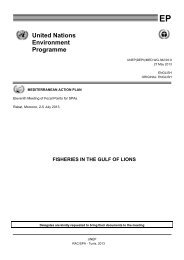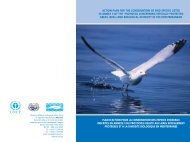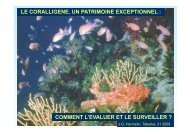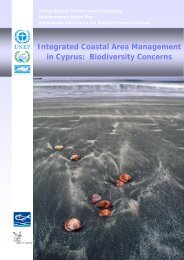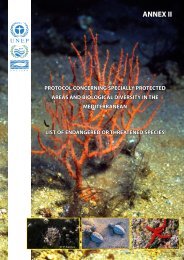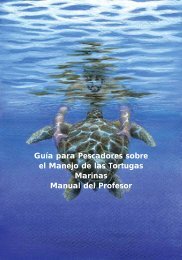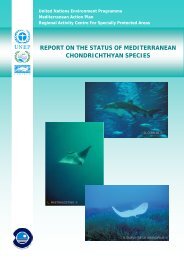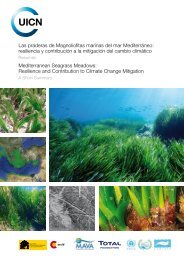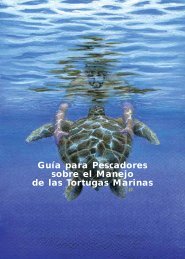Proceedings of the Second Mediterranean Symposium on Marine
Proceedings of the Second Mediterranean Symposium on Marine
Proceedings of the Second Mediterranean Symposium on Marine
You also want an ePaper? Increase the reach of your titles
YUMPU automatically turns print PDFs into web optimized ePapers that Google loves.
PROCEEDINGS OF THE SECOND MEDITERRANEAN SYMPOSIUM ON MARINE VEGETATION (ATHENS, 12-13 DECEMBER 2003)<br />
178<br />
The temporal evoluti<strong>on</strong> in <str<strong>on</strong>g>the</str<strong>on</strong>g> scales shows different tendencies for <str<strong>on</strong>g>the</str<strong>on</strong>g> three sites. For<br />
Bastia, a significant decrease <str<strong>on</strong>g>of</str<strong>on</strong>g> <str<strong>on</strong>g>the</str<strong>on</strong>g> mercury c<strong>on</strong>centrati<strong>on</strong> is noted (Kruskall Wallis, p <<br />
0.05) from 1997 to 1999, <str<strong>on</strong>g>the</str<strong>on</strong>g>n from 2000 to 2001 (Table 1). For Lumio and<br />
Macinaggio, <str<strong>on</strong>g>the</str<strong>on</strong>g> observed variati<strong>on</strong>s are not significant (Kruskall Wallis, p ≥ 0.05; ANOVA,<br />
p ≥ 0.05), never<str<strong>on</strong>g>the</str<strong>on</strong>g>less for Macinaggio an increase <str<strong>on</strong>g>of</str<strong>on</strong>g> <str<strong>on</strong>g>the</str<strong>on</strong>g> c<strong>on</strong>centrati<strong>on</strong>s until 1999 and<br />
a decrease since <str<strong>on</strong>g>the</str<strong>on</strong>g>n are observed (Table 1). C<strong>on</strong>versely, <str<strong>on</strong>g>the</str<strong>on</strong>g> temporal evoluti<strong>on</strong> <str<strong>on</strong>g>of</str<strong>on</strong>g><br />
mercury c<strong>on</strong>centrati<strong>on</strong>s in <str<strong>on</strong>g>the</str<strong>on</strong>g> rhizomes is comparable for <str<strong>on</strong>g>the</str<strong>on</strong>g> three sites (ANOVA, p ≥<br />
0.05), with a significant increase from 1998 to 2001 (ANOVA, p = 0.00001; Table 1).<br />
DISCUSSION AND CONCLUSION<br />
The results c<strong>on</strong>firm <str<strong>on</strong>g>the</str<strong>on</strong>g> importance <str<strong>on</strong>g>of</str<strong>on</strong>g> <str<strong>on</strong>g>the</str<strong>on</strong>g> different factors (nature <str<strong>on</strong>g>of</str<strong>on</strong>g> <str<strong>on</strong>g>the</str<strong>on</strong>g> tissue, site and year)<br />
<strong>on</strong> <str<strong>on</strong>g>the</str<strong>on</strong>g> mercury c<strong>on</strong>tents accumulated by <str<strong>on</strong>g>the</str<strong>on</strong>g> marine magnoliophyta Posid<strong>on</strong>ia oceanica.<br />
The tissue factor plays a determinant role, with higher c<strong>on</strong>centrati<strong>on</strong>s in <str<strong>on</strong>g>the</str<strong>on</strong>g> rhizomes<br />
than in <str<strong>on</strong>g>the</str<strong>on</strong>g> scales. This preferential accumulati<strong>on</strong> in <str<strong>on</strong>g>the</str<strong>on</strong>g> rhizomes has ever been notified<br />
by several authors (Capiom<strong>on</strong>t, 2000; Maserti et al., 1991). It can be due to <str<strong>on</strong>g>the</str<strong>on</strong>g> fact that<br />
mercurial absorpti<strong>on</strong> is mainly made by <str<strong>on</strong>g>the</str<strong>on</strong>g> root system in Posid<strong>on</strong>ia oceanica (Ferrara<br />
and Serriti, 1989; Maserti et al., 1988). It can be also due to <str<strong>on</strong>g>the</str<strong>on</strong>g> fact that rhizomes are<br />
living organs (Francour, 1985) which c<strong>on</strong>tinue having a functi<strong>on</strong>al activity, and so<br />
accumulating trace-metals, during several years, whereas scales (dead organs) have no<br />
active accumulati<strong>on</strong> (Pergent, 1987). A different accumulati<strong>on</strong> (availability <str<strong>on</strong>g>of</str<strong>on</strong>g> <str<strong>on</strong>g>the</str<strong>on</strong>g><br />
chemical forms) by <str<strong>on</strong>g>the</str<strong>on</strong>g> rhizomes and <str<strong>on</strong>g>the</str<strong>on</strong>g> foliar tissues, especially with regards to <str<strong>on</strong>g>the</str<strong>on</strong>g><br />
petioles (future scales), can not be excluded, as this difference <str<strong>on</strong>g>of</str<strong>on</strong>g> behaviour is also<br />
observed at <str<strong>on</strong>g>the</str<strong>on</strong>g> level <str<strong>on</strong>g>of</str<strong>on</strong>g> <str<strong>on</strong>g>the</str<strong>on</strong>g> different sites.<br />
So c<strong>on</strong>sidering <strong>on</strong>ly <str<strong>on</strong>g>the</str<strong>on</strong>g> c<strong>on</strong>centrati<strong>on</strong>s in <str<strong>on</strong>g>the</str<strong>on</strong>g> rhizomes, Bastia, Lumio and Macinaggio<br />
seem to behave equally. C<strong>on</strong>versely, <str<strong>on</strong>g>the</str<strong>on</strong>g> c<strong>on</strong>tents recorded in <str<strong>on</strong>g>the</str<strong>on</strong>g> scales individualize <str<strong>on</strong>g>the</str<strong>on</strong>g><br />
site <str<strong>on</strong>g>of</str<strong>on</strong>g> Bastia as more c<strong>on</strong>taminated than <str<strong>on</strong>g>the</str<strong>on</strong>g> two o<str<strong>on</strong>g>the</str<strong>on</strong>g>rs sites. C<strong>on</strong>sequently <str<strong>on</strong>g>the</str<strong>on</strong>g> factor<br />
site seems to be able to overimpose and/or to modify <str<strong>on</strong>g>the</str<strong>on</strong>g> behaviour <str<strong>on</strong>g>of</str<strong>on</strong>g> <str<strong>on</strong>g>the</str<strong>on</strong>g> different<br />
tissues. With regards to <str<strong>on</strong>g>the</str<strong>on</strong>g> literature data (Capiom<strong>on</strong>t, 2000; Pergent-Martini and<br />
Pergent, 2000; Sanchiz et al., 1999), <str<strong>on</strong>g>the</str<strong>on</strong>g> values measured in this study stay relatively<br />
weak, for <str<strong>on</strong>g>the</str<strong>on</strong>g> scales and <str<strong>on</strong>g>the</str<strong>on</strong>g> rhizomes as well as for <str<strong>on</strong>g>the</str<strong>on</strong>g> belowground biomass in its<br />
whole, with c<strong>on</strong>centrati<strong>on</strong>s between 50 and 70 ng.g -1 . These values can be c<strong>on</strong>sidered<br />
as <str<strong>on</strong>g>the</str<strong>on</strong>g> back noise <str<strong>on</strong>g>of</str<strong>on</strong>g> <str<strong>on</strong>g>the</str<strong>on</strong>g> <str<strong>on</strong>g>Mediterranean</str<strong>on</strong>g> Sea.<br />
The mercury c<strong>on</strong>centrati<strong>on</strong>s study shows that interannual variati<strong>on</strong>s exist at <str<strong>on</strong>g>the</str<strong>on</strong>g> general<br />
level (all sites and tissues mingled), as at <str<strong>on</strong>g>the</str<strong>on</strong>g> level <str<strong>on</strong>g>of</str<strong>on</strong>g> a given tissue (Table 1). So, 2001<br />
appears significantly weaker than <str<strong>on</strong>g>the</str<strong>on</strong>g> o<str<strong>on</strong>g>the</str<strong>on</strong>g>r years, if <strong>on</strong>ly mercury c<strong>on</strong>centrati<strong>on</strong>s in <str<strong>on</strong>g>the</str<strong>on</strong>g><br />
scales, all sites mingled, are c<strong>on</strong>sidered (Table 1). However, it is difficult to know if this<br />
reducti<strong>on</strong> <str<strong>on</strong>g>of</str<strong>on</strong>g> mercury c<strong>on</strong>centrati<strong>on</strong>s in <str<strong>on</strong>g>the</str<strong>on</strong>g> scales is correlated to a decrease <str<strong>on</strong>g>of</str<strong>on</strong>g> this metal<br />
in <str<strong>on</strong>g>the</str<strong>on</strong>g> coastal envir<strong>on</strong>ment or if it <strong>on</strong>ly reflects a passive accumulati<strong>on</strong> <str<strong>on</strong>g>of</str<strong>on</strong>g> mercury<br />
(adsorpti<strong>on</strong>), during <str<strong>on</strong>g>the</str<strong>on</strong>g> ageing <str<strong>on</strong>g>of</str<strong>on</strong>g> <str<strong>on</strong>g>the</str<strong>on</strong>g> scales or if it illustrates mechanisms <str<strong>on</strong>g>of</str<strong>on</strong>g> biological<br />
diluti<strong>on</strong>. Indeed, Capiom<strong>on</strong>t (2000) shows that during <str<strong>on</strong>g>the</str<strong>on</strong>g> ageing <str<strong>on</strong>g>of</str<strong>on</strong>g> <str<strong>on</strong>g>the</str<strong>on</strong>g> scales, <str<strong>on</strong>g>the</str<strong>on</strong>g>re is a<br />
loss <str<strong>on</strong>g>of</str<strong>on</strong>g> biomass <str<strong>on</strong>g>of</str<strong>on</strong>g> <str<strong>on</strong>g>the</str<strong>on</strong>g>se <strong>on</strong>es and that this loss is accompanied by an increase <str<strong>on</strong>g>of</str<strong>on</strong>g> <str<strong>on</strong>g>the</str<strong>on</strong>g><br />
mercury c<strong>on</strong>centrati<strong>on</strong>s whereas <str<strong>on</strong>g>the</str<strong>on</strong>g> total quantities <str<strong>on</strong>g>of</str<strong>on</strong>g> mercury decrease weakly.<br />
According to this author, mercury could be c<strong>on</strong>sequently associated to a more refractory




